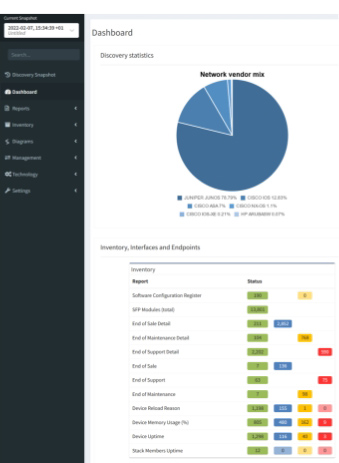

For all the tools and tricks the 2023 network engineer has up their sleeve, the modern enterprise meets them with a new challenge. Some are brand-new problems introduced by new technologies, and some are classic struggles exacerbated by the relentless pace of enterprise operations and innovation. Both mean constantly increasing demands on the network that underpins the success of your business. And of course, pressure on the network means pressure on network engineers, who must balance these business demands with a network that is secure, resilient, and agile.
The result is a living ecosystem, and just like a dense rainforest where the flap of a butterfly's wings might mean tomorrow's thunderstorm, your network is continuously subject to ever-changing influences and pressures. As these pressures stack up, so do the expectations that the network operates smoothly at all times - the network is, after all, business-critical. The network engineer of 2023 is something like a nature guide, protecting, learning, and guiding users through the network safely; anticipating changes and mitigating threats; maintaining balance for a successful circle of life.

In understanding how to navigate this on an organizational level – with the right tools, the right data shared between teams, and adherence to a stated network intent – we must trace how business demands translate to technical network complexity.
Only then can we ensure that the David Attenboroughs, Steve Irwins, and Eliza Thornberrys of enterprise networking have the tools they need to meet the challenge (ahem - pick your fighter!).
In our globalized economy, enterprises today are typically distributed, spanning multiple locations and supporting more devices, applications, and unpredictable users than ever before.
Different locations or business units may have different policies and regulations (bring-your-own-device, IoT, remote work) and the network team must account for all of it.
Enterprises are readying for this in general, with a recent survey revealing that with regard to “supporting a digital-ready workplace and hybrid work environment, 84% of all firms said they would invest in “future of work” initiatives.”
However, they may not yet understand just how central the network will be to their success here, as networking and associate infrastructures are ranked as low spending priorities.
It is essential that enterprises understand how investing in their network infrastructure will affect their business from every angle, including top priorities like cybersecurity.
Highly large, distributed networks mean the following for the engineers who manage them:
*IP Fabric helped solve this issue for Dr. Max - see how we did it.

Whatever platform or services an end user engages with, today they expect the same connectivity as if they were plugged into the wall on location. SaaS applications, hybrid IT environments, remote accessibility – the expectation is seamless and continuous connectivity. Managing this interconnectivity on an enterprise scale is not easy.
72% of organizations treat home offices as corporate endpoints that require network visibility and management using centralized enterprise solutions. (Enterprise Strategy Group, April 2023)
As more industries employ technology that relies on the network to function, meeting these connectivity expectations is not only a business initiative but essential for the provision of critical services like healthcare, education, and financial services for all.
This continuous network availability means that engineering teams need:
We’ve already mentioned Cloud connectivity, but the growing prevalence of cloud, hybrid, or multi-cloud networks also introduces a knowledge and skills gap in enterprises that increases complexity. Smooth team collaboration is essential for enterprises to operate at pace, and these gaps require a normalized, end-to-end understanding of the network for engineering teams regardless of the environment.
IDC predicts that “By 2025, to ensure data and workflow integrations spanning distributed clouds and edge environments, 50% of enterprises will deploy multi-cloud networking.”
For teams to navigate the modern multidomain network successfully, they need:
A single-vendor shop is becoming more of a rarity as enterprises have more options to kit out their network with specialized tooling. Though this spreads some risk and allows for more specific tool selection, it does add complexity to network management, with vendor-specific knowledge required to manage, maintain, and troubleshoot the network.
Recent EMA research cited four main pain points for multivendor SD-WANs: consistent security, skills gaps, costs, and poor cloud access. All of this stems from vendor variation in how network devices are operated and behave.
To have a useful network baseline, this heterogenous data:
With this in place, teams can successfully navigate or even mitigate the aforementioned pain points.
The growing number and sophistication of cybersecurity threats loom over enterprises, making cybersecurity a top priority. Securing the network involves deploying firewalls (from different vendors, next-generation firewalls), intrusion detection and prevention systems, encryption mechanisms, authentication protocols, and more.
Managing both internal security policies and ensuring compliance with industry regulations makes securing the enterprise network a complicated game and with all the previously mentioned moving parts, not a game that ever really ends.
To effectively secure a modern enterprise network, you need:

So, with all of these stated needs that are starting to seem non-negotiable for networking teams, how does a business provide the tools necessary to keep the network, and therefore business, running smoothly?
Step one is to understand your environment, from end to end. You cannot control what you do not first know; if your network is a rainforest, then network assurance is the GPS, aerial photography, and high-beam headlights all in one. Get exploring with our self-guided demo or reach out for a demo catered to your particular rainforest.
For all the tools and tricks the 2023 network engineer has up their sleeve, the modern enterprise meets them with a new challenge. Some are brand-new problems introduced by new technologies, and some are classic struggles exacerbated by the relentless pace of enterprise operations and innovation. Both mean constantly increasing demands on the network that underpins the success of your business. And of course, pressure on the network means pressure on network engineers, who must balance these business demands with a network that is secure, resilient, and agile.
The result is a living ecosystem, and just like a dense rainforest where the flap of a butterfly's wings might mean tomorrow's thunderstorm, your network is continuously subject to ever-changing influences and pressures. As these pressures stack up, so do the expectations that the network operates smoothly at all times - the network is, after all, business-critical. The network engineer of 2023 is something like a nature guide, protecting, learning, and guiding users through the network safely; anticipating changes and mitigating threats; maintaining balance for a successful circle of life.

In understanding how to navigate this on an organizational level – with the right tools, the right data shared between teams, and adherence to a stated network intent – we must trace how business demands translate to technical network complexity.
Only then can we ensure that the David Attenboroughs, Steve Irwins, and Eliza Thornberrys of enterprise networking have the tools they need to meet the challenge (ahem - pick your fighter!).
In our globalized economy, enterprises today are typically distributed, spanning multiple locations and supporting more devices, applications, and unpredictable users than ever before.
Different locations or business units may have different policies and regulations (bring-your-own-device, IoT, remote work) and the network team must account for all of it.
Enterprises are readying for this in general, with a recent survey revealing that with regard to “supporting a digital-ready workplace and hybrid work environment, 84% of all firms said they would invest in “future of work” initiatives.”
However, they may not yet understand just how central the network will be to their success here, as networking and associate infrastructures are ranked as low spending priorities.
It is essential that enterprises understand how investing in their network infrastructure will affect their business from every angle, including top priorities like cybersecurity.
Highly large, distributed networks mean the following for the engineers who manage them:
*IP Fabric helped solve this issue for Dr. Max - see how we did it.

Whatever platform or services an end user engages with, today they expect the same connectivity as if they were plugged into the wall on location. SaaS applications, hybrid IT environments, remote accessibility – the expectation is seamless and continuous connectivity. Managing this interconnectivity on an enterprise scale is not easy.
72% of organizations treat home offices as corporate endpoints that require network visibility and management using centralized enterprise solutions. (Enterprise Strategy Group, April 2023)
As more industries employ technology that relies on the network to function, meeting these connectivity expectations is not only a business initiative but essential for the provision of critical services like healthcare, education, and financial services for all.
This continuous network availability means that engineering teams need:
We’ve already mentioned Cloud connectivity, but the growing prevalence of cloud, hybrid, or multi-cloud networks also introduces a knowledge and skills gap in enterprises that increases complexity. Smooth team collaboration is essential for enterprises to operate at pace, and these gaps require a normalized, end-to-end understanding of the network for engineering teams regardless of the environment.
IDC predicts that “By 2025, to ensure data and workflow integrations spanning distributed clouds and edge environments, 50% of enterprises will deploy multi-cloud networking.”
For teams to navigate the modern multidomain network successfully, they need:
A single-vendor shop is becoming more of a rarity as enterprises have more options to kit out their network with specialized tooling. Though this spreads some risk and allows for more specific tool selection, it does add complexity to network management, with vendor-specific knowledge required to manage, maintain, and troubleshoot the network.
Recent EMA research cited four main pain points for multivendor SD-WANs: consistent security, skills gaps, costs, and poor cloud access. All of this stems from vendor variation in how network devices are operated and behave.
To have a useful network baseline, this heterogenous data:
With this in place, teams can successfully navigate or even mitigate the aforementioned pain points.
The growing number and sophistication of cybersecurity threats loom over enterprises, making cybersecurity a top priority. Securing the network involves deploying firewalls (from different vendors, next-generation firewalls), intrusion detection and prevention systems, encryption mechanisms, authentication protocols, and more.
Managing both internal security policies and ensuring compliance with industry regulations makes securing the enterprise network a complicated game and with all the previously mentioned moving parts, not a game that ever really ends.
To effectively secure a modern enterprise network, you need:

So, with all of these stated needs that are starting to seem non-negotiable for networking teams, how does a business provide the tools necessary to keep the network, and therefore business, running smoothly?
Step one is to understand your environment, from end to end. You cannot control what you do not first know; if your network is a rainforest, then network assurance is the GPS, aerial photography, and high-beam headlights all in one. Get exploring with our self-guided demo or reach out for a demo catered to your particular rainforest.




